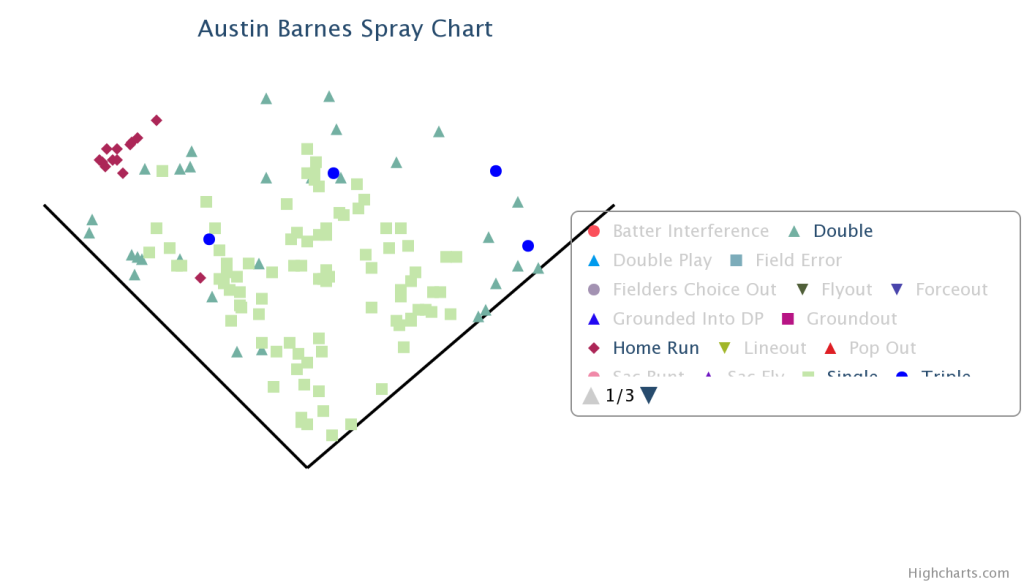Austin Barnes is one of the prospects that was acquired by the Dodgers in the Dee Gordon-for-Andrew Heaney-for-Howie Kendrick swap with the Marlins and Angels, and like the other players acquired by the Dodgers in the deal (Chris Hatcher, Enrique Hernandez), he’s a legitimate asset.
Barnes was a ninth-round selection of the Marlins back in 2011. As college player out of Arizona State, Barnes signed for a mere $95,000. A converted second baseman, he’s gone on to spend his time on the diamond primarily behind the plate as a catcher, but also has a lot of experience at second base, and even played some third base in 2014.
—–
The newly 25-year-old Barnes has always been at about the league-average age, which is a bit old for highly touted prospects (at Joc Pederson‘s age, Barnes was in A-ball). Nevertheless, he’s put together solid lines at A- (.288/.369/.361/.730), A (.318/.401/.481/.882), and A+ (.279/.373/.368/.741). Barnes hasn’t always shown the power, nor the raw tools, to generate fanfare, but he’s been productive via a combination of plate discipline and consistent hard contact. Despite his age, it’s his performance at AA that gives some hope that he could still have potential as a regular. In 422 plate appearances at the level, he’s produced a .303/.413/.503/.916 line, with a K/BB ratio of 46/66, 39 extra-base hits, and eight stolen bases without being thrown out, for good measure. Furthermore, against prospects within an organization’s top 20, Barnes has hit .305 with 17 XBH, and 25 BB to 32 K in 196 PA from 2013 to 2014.
—–
Barnes accomplished his production against advanced competition by taking an all-fields approach with his compact swing. Barnes has the bat control to consistently square up pitches and hit the ball with authority even when the result isn’t necessarily a line drive. Rarely will he give away plate appearances, and he fits into the scrappy cliche at the plate. As a result of both his swing and approach, power numbers should decrease rather than progress as he moves up levels. And that prediction is bolstered by fringy raw power.
As you can see, most of Barnes’ pop is dead pull, but his other hits are sprayed all over the park.
Barnes isn’t a fast runner, but like most other aspects of his game, he knows what he’s doing and will take advantage of situations. Defensively, he’s thrown out 36% of would-be basestealers in his MILB career, most of that coming through superior quickness and athleticism more than arm strength. Barnes is also a solid receiver and handles balls in the dirt well. As an infielder, Barnes can handle both second and third proficiently enough, which opens up further opportunity for him to make the Dodgers should he not end up settling as a regular at one position.
Vince Lara-Cinisomo of Baseball America had this to say about Barnes:
Officials in and out of the organization laud Barnes’ bat, makeup and leadership skills. He makes a lot of hard contact thanks to a gap-to-gap approach, barrel awareness and excellent hand-eye coordination. He has below-average power and speed. Defensively, Barnes fits best as a catcher, where he’s an average receiver and thrower whose instincts and accuracy helped him throw out 37 percent of basestealers in 2014. At the very least, thanks to his second base play, Barnes should enjoy a role as a solid utility player.
Based on his age and lack of outstanding tools, the most realistic expectation would be to peg him as a super-utility type player on an MLB roster. However, there’s potential for him to develop into a regular behind the plate (or at least a backup), and given the non-existent depth in the Dodgers minors at the position, Barnes counts as a very intriguing and very welcome addition to the organization.
 Dodgers Digest Los Angeles Dodgers Baseball Blog
Dodgers Digest Los Angeles Dodgers Baseball Blog
